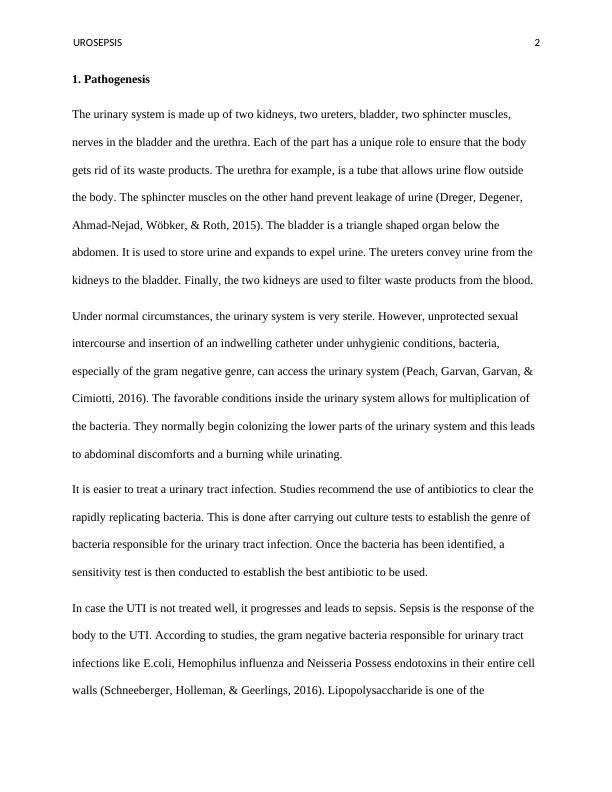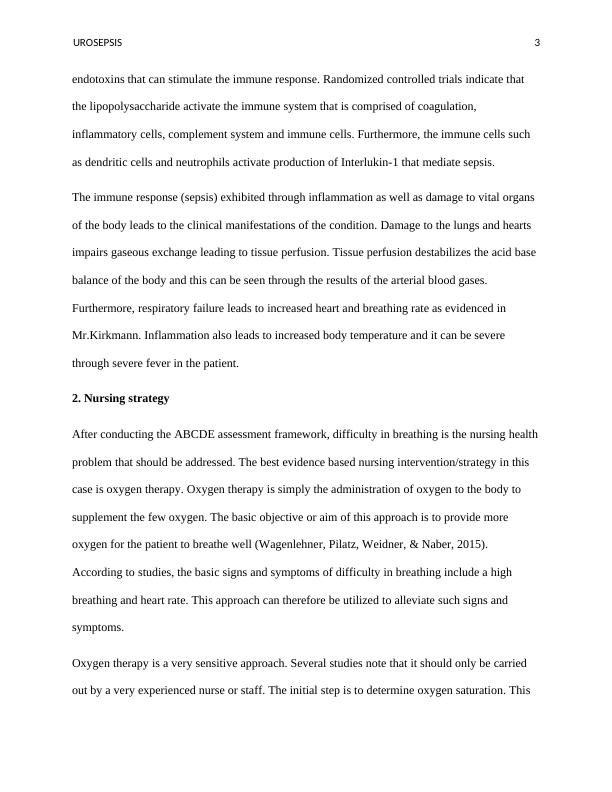Urosepsis: Pathogenesis, Nursing Strategy, and Analysis of Arterial Blood Gases
Added on 2023-03-21
7 Pages1868 Words95 Views
Running head: UROSEPSIS 1
Urosepsis
Name:
Institution:
Tutor:
Date:
Urosepsis
Name:
Institution:
Tutor:
Date:

UROSEPSIS 2
1. Pathogenesis
The urinary system is made up of two kidneys, two ureters, bladder, two sphincter muscles,
nerves in the bladder and the urethra. Each of the part has a unique role to ensure that the body
gets rid of its waste products. The urethra for example, is a tube that allows urine flow outside
the body. The sphincter muscles on the other hand prevent leakage of urine (Dreger, Degener,
Ahmad-Nejad, Wöbker, & Roth, 2015). The bladder is a triangle shaped organ below the
abdomen. It is used to store urine and expands to expel urine. The ureters convey urine from the
kidneys to the bladder. Finally, the two kidneys are used to filter waste products from the blood.
Under normal circumstances, the urinary system is very sterile. However, unprotected sexual
intercourse and insertion of an indwelling catheter under unhygienic conditions, bacteria,
especially of the gram negative genre, can access the urinary system (Peach, Garvan, Garvan, &
Cimiotti, 2016). The favorable conditions inside the urinary system allows for multiplication of
the bacteria. They normally begin colonizing the lower parts of the urinary system and this leads
to abdominal discomforts and a burning while urinating.
It is easier to treat a urinary tract infection. Studies recommend the use of antibiotics to clear the
rapidly replicating bacteria. This is done after carrying out culture tests to establish the genre of
bacteria responsible for the urinary tract infection. Once the bacteria has been identified, a
sensitivity test is then conducted to establish the best antibiotic to be used.
In case the UTI is not treated well, it progresses and leads to sepsis. Sepsis is the response of the
body to the UTI. According to studies, the gram negative bacteria responsible for urinary tract
infections like E.coli, Hemophilus influenza and Neisseria Possess endotoxins in their entire cell
walls (Schneeberger, Holleman, & Geerlings, 2016). Lipopolysaccharide is one of the
1. Pathogenesis
The urinary system is made up of two kidneys, two ureters, bladder, two sphincter muscles,
nerves in the bladder and the urethra. Each of the part has a unique role to ensure that the body
gets rid of its waste products. The urethra for example, is a tube that allows urine flow outside
the body. The sphincter muscles on the other hand prevent leakage of urine (Dreger, Degener,
Ahmad-Nejad, Wöbker, & Roth, 2015). The bladder is a triangle shaped organ below the
abdomen. It is used to store urine and expands to expel urine. The ureters convey urine from the
kidneys to the bladder. Finally, the two kidneys are used to filter waste products from the blood.
Under normal circumstances, the urinary system is very sterile. However, unprotected sexual
intercourse and insertion of an indwelling catheter under unhygienic conditions, bacteria,
especially of the gram negative genre, can access the urinary system (Peach, Garvan, Garvan, &
Cimiotti, 2016). The favorable conditions inside the urinary system allows for multiplication of
the bacteria. They normally begin colonizing the lower parts of the urinary system and this leads
to abdominal discomforts and a burning while urinating.
It is easier to treat a urinary tract infection. Studies recommend the use of antibiotics to clear the
rapidly replicating bacteria. This is done after carrying out culture tests to establish the genre of
bacteria responsible for the urinary tract infection. Once the bacteria has been identified, a
sensitivity test is then conducted to establish the best antibiotic to be used.
In case the UTI is not treated well, it progresses and leads to sepsis. Sepsis is the response of the
body to the UTI. According to studies, the gram negative bacteria responsible for urinary tract
infections like E.coli, Hemophilus influenza and Neisseria Possess endotoxins in their entire cell
walls (Schneeberger, Holleman, & Geerlings, 2016). Lipopolysaccharide is one of the

UROSEPSIS 3
endotoxins that can stimulate the immune response. Randomized controlled trials indicate that
the lipopolysaccharide activate the immune system that is comprised of coagulation,
inflammatory cells, complement system and immune cells. Furthermore, the immune cells such
as dendritic cells and neutrophils activate production of Interlukin-1 that mediate sepsis.
The immune response (sepsis) exhibited through inflammation as well as damage to vital organs
of the body leads to the clinical manifestations of the condition. Damage to the lungs and hearts
impairs gaseous exchange leading to tissue perfusion. Tissue perfusion destabilizes the acid base
balance of the body and this can be seen through the results of the arterial blood gases.
Furthermore, respiratory failure leads to increased heart and breathing rate as evidenced in
Mr.Kirkmann. Inflammation also leads to increased body temperature and it can be severe
through severe fever in the patient.
2. Nursing strategy
After conducting the ABCDE assessment framework, difficulty in breathing is the nursing health
problem that should be addressed. The best evidence based nursing intervention/strategy in this
case is oxygen therapy. Oxygen therapy is simply the administration of oxygen to the body to
supplement the few oxygen. The basic objective or aim of this approach is to provide more
oxygen for the patient to breathe well (Wagenlehner, Pilatz, Weidner, & Naber, 2015).
According to studies, the basic signs and symptoms of difficulty in breathing include a high
breathing and heart rate. This approach can therefore be utilized to alleviate such signs and
symptoms.
Oxygen therapy is a very sensitive approach. Several studies note that it should only be carried
out by a very experienced nurse or staff. The initial step is to determine oxygen saturation. This
endotoxins that can stimulate the immune response. Randomized controlled trials indicate that
the lipopolysaccharide activate the immune system that is comprised of coagulation,
inflammatory cells, complement system and immune cells. Furthermore, the immune cells such
as dendritic cells and neutrophils activate production of Interlukin-1 that mediate sepsis.
The immune response (sepsis) exhibited through inflammation as well as damage to vital organs
of the body leads to the clinical manifestations of the condition. Damage to the lungs and hearts
impairs gaseous exchange leading to tissue perfusion. Tissue perfusion destabilizes the acid base
balance of the body and this can be seen through the results of the arterial blood gases.
Furthermore, respiratory failure leads to increased heart and breathing rate as evidenced in
Mr.Kirkmann. Inflammation also leads to increased body temperature and it can be severe
through severe fever in the patient.
2. Nursing strategy
After conducting the ABCDE assessment framework, difficulty in breathing is the nursing health
problem that should be addressed. The best evidence based nursing intervention/strategy in this
case is oxygen therapy. Oxygen therapy is simply the administration of oxygen to the body to
supplement the few oxygen. The basic objective or aim of this approach is to provide more
oxygen for the patient to breathe well (Wagenlehner, Pilatz, Weidner, & Naber, 2015).
According to studies, the basic signs and symptoms of difficulty in breathing include a high
breathing and heart rate. This approach can therefore be utilized to alleviate such signs and
symptoms.
Oxygen therapy is a very sensitive approach. Several studies note that it should only be carried
out by a very experienced nurse or staff. The initial step is to determine oxygen saturation. This

End of preview
Want to access all the pages? Upload your documents or become a member.
Related Documents
Urinary Tract Infection with Sepsislg...
|8
|1877
|97
Case Study on Urosepsislg...
|6
|1636
|94
A Case Study on Urosepsislg...
|7
|1800
|84
Urinary Tract Infection with Sepsislg...
|7
|1908
|1
Analyzing Pathogenesis and Clinical Manifestation of Sepsislg...
|7
|1846
|76
Urosepsis: Pathogenesis, Nursing Strategy, and ABG Analysislg...
|8
|2294
|341
